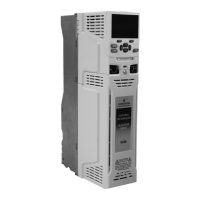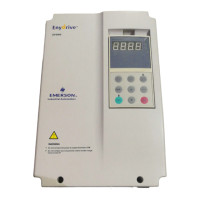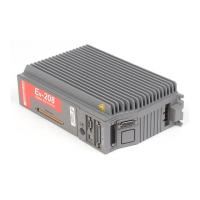Safety
information
Product
information
Mechanical
installation
Electrical
installation
Getting
started
User Menu A Commissioning
Advanced
Parameters
Diagnostics Optimization CT MODBUS RTU Technical Data
350 E300 Design Guide
Issue Number: 1
For a given integral gain the damping can be improved by increasing the proportional gain. A compromise must be reached where the system
response, stiffness and damping are all adequate for the application. The integral term is implemented in the form of ∑(Ki x error), and so the integral
gain can be changed when the controller is active without causing large transients on the torque reference.
To analyze the performance of the speed controller it may be represented as an s-domain model as shown below.
Kc' is the conversion between the speed controller output and the torque producing current reference. A value of unity at the output of the speed
controller gives a torque producing current equal to Kc'. The drive automatically compensates the torque producing current reference for flux
variations in field weakening, and so Kc' can be assumed to have a constant value even in field weakening. Kc' = Drive Full Scale Current Kc (J06) x
0.45.
Kt is the torque constant of the motor (i.e. torque in Nm per amp of torque producing current). This value is normally available from the manufacturer
for a permanent magnet motor, however, for induction motors the value must be calculated from the motor parameters. In RFC-A mode this
calculation is performed by the drive and the result is stored in Torque Per Amp (E16)
L(s) is the transfer function of the load.
The speed controller calculations are provided for a rotary application. However, for a linear application it is possible to set Torque Per Amp (E16) to
the force per amp and the Inertia Compensation Total Inertia (E15) to the mass, and all the rotary system equations still apply.
See Final Speed Loop Kp (J33).
This parameter indicates the field weakening current while the elevator drive is running. The value is based upon the rated magnetizing current and
the actual magnetizing current, Magnetizing Current (J25).
Open loop, RFC-A:
This parameter displays the minimum magnetizing current as a percentage of rated magnetizing current when travelling.
For induction motors with a correct motor setup, this parameter should be in the region of 95 % to 100 %. If it is below 90 % the motor map setting
may be incorrect where the motor is operating in field weakening indicated by the reduced magnetizing current.
RFC-S:
For PM motors Magnetizing Current (J25) shows the maximum reactive current for field weakening if high speed mode is enabled with Enable High
Speed Mode (B28) = On (1). The field weakening magnetizing current is calculated from:
100 - (MAX(Magnetizing Current (J25)) * 100 / Motor Rated Current (B02))
This provides a similar value to Open loop / RFC-A.
J34 Final Speed Loop Ki
Mode RFC-A, RFC-S
Minimum 0.00 Maximum 655.35
Default 0.10 Units s²/rad
Type 16 Bit User Save Update Rate 4 ms read
Display Format Standard Decimal Places 2
Coding RW, BU
Speed controller (s domain)
_
+ Kp
Ki / s +
+
L(s)Kc’ Kt
w*(s)
(rad/s)
w(s)
(rad/s)
Speed controller
J35 Field Weakening Magnetizing Current
Mode Open-Loop, RFC-A, RFC-S
Minimum 0 Maximum 100
Default Units %
Type 8 Bit Volatile Update Rate Background
Display Format Standard Decimal Places 0
Coding RO, ND, NC, PT

